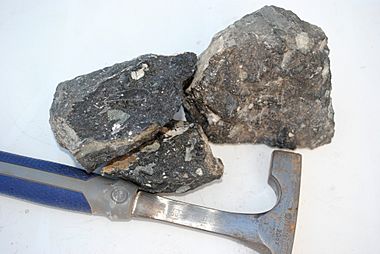Elliott County Kimberlite facts for kids
The Elliott County Kimberlite, sometimes called the Ison Creek Kimberlite, is a special type of rock found in Elliott County, Kentucky. It was first discovered way back in 1884 by Albert R. Crandall. This was even before the rock type "kimberlite" got its name from a similar rock found near Kimberley, South Africa!
This kimberlite appears as three separate, long rock bodies. Each one is about 1/4 to 1/2 mile long and a few hundred feet wide. They are all found within an area of about one square mile.
Contents
What is the Elliott County Kimberlite?
This rock is a dark-green type of rock called peridotite, which is a kind of kimberlite. It's mostly made of a mineral called olivine, which has changed over time into a softer material called serpentine.
What Minerals Are Inside?
Besides olivine, the kimberlite also contains other interesting minerals. These include:
- Phlogopite (a type of mica)
- Pyrope (a red garnet)
- Calcite
- Enstatite
- Magnesian ilmenite (a dark, heavy mineral)
What Else Can You Find in the Rock?
Scientists have found other pieces of rock mixed into the kimberlite. These are called xenoliths, which means "foreign rocks." Most of these are pieces of shale, a common type of sedimentary rock. There are also pieces of other igneous rocks (rocks formed from cooled magma). William Brown described these in 1977.
How Old is This Rock?
Scientists have studied the Elliott County Kimberlite to figure out its age. Early tests suggested it formed during the Permian Period, which was about 299 to 252 million years ago. However, newer evidence suggests it might be younger, forming during the Cretaceous Period, which was about 145 to 66 million years ago.
What Does the Rock Look Like?
The Elliott County Kimberlite isn't usually found sticking out of the ground. This is because it's not very resistant to weathering, meaning it breaks down easily. Sometimes, it can be broken down up to 50 feet deep!
When the rock is fresh and hasn't been weathered, it's hard and a dark greenish-black color. As it weathers, it turns a grayish-olive color. The soil that forms from this weathered rock, called saprolite, is yellowish to reddish-brown. You can often find fragments of garnet and ilmenite, along with other rock pieces, scattered in this soil.
Looking for Diamonds
People have tried several times to find diamonds in the Elliott County Kimberlite. However, so far, no diamonds have been found there.


